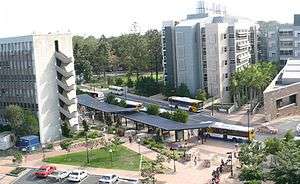Institute for Molecular Bioscience
|
IMB in the background | |
| Established | 2000 |
|---|---|
| Research type | Fundamental and Applied research |
| Budget | $AUD62 million (income) {2013}[1] |
Field of research | Molecular Biology, Genetics, Physiology, Biotechnology, Drug discovery, Pharmacology, Genomics |
| Director | Brandon Wainwright |
| Faculty | Faculty of Science |
| Location |
Brisbane, QLD, Australia 27°29′49″S 153°00′32″E / 27.497°S 153.009°ECoordinates: 27°29′49″S 153°00′32″E / 27.497°S 153.009°E |
Zip code | 4067 |
| Campus | St Lucia, Queensland |
| Affiliations | University of Queensland |
| Website | Official website |
The Institute for Molecular Bioscience (IMB) is a mulidisciplinary scientific research facility housed within the Queensland Bioscience Precinct of the University of Queensland, Brisbane, Australia. Its aim is to "decipher the information contained in the genes, proteins and molecules of humans, animals and plants".[2]


Building
The building is housed in the University's St Lucia campus, in the corner of Chancellor's Place and Hood Street, just opposite the University of Queensland bus station. The building also houses a notable auditorium for the University.
Management
IMB houses 500 researchers, postgraduate students and support staff.[3] They are distributed among 7 "impact areas": cancer, pain, childhood diseases, infection and inflammation, diabetes and obesity, agriculture, and clean energy; these are in turn placed within its 3 stated "research divisions": Chemistry and Structural Biology Division, Genomics of Development and Disease Division, and Cell Biology and Molecular Medicine Division.[3] The Institute's research outcomes are commercialised by the University-owned group UniQuest.
It is managed by a Director, a Board, and a Scientific Advisory Committee.[4] Its current director is Brandon Wainwright, while Jennifer Stow is the Deputy Director (Research),[5] and the Board is formed by John Funder, Bob Christiansen, Cherrell Hirst, Max Lu, Stephen Walker, and Jane Wilson.[6]
Laboratories
Within its three Divisions, the labs include several spectrometry, imaging, crystallisation and state of the art microscopy facilities.[7]
David Fairlie heads the Chemistry division; Mark Ragan and Ben Hogan head the Genomics division and Alpha Yap heads the division of Cell Biology and Molecular Medicine.[8][9][10]
Research
Research undertaken at the IMB has been covered in the media, such as its work with oil-producing small algae, growing of kidney from iPS stem cells, its research into spider venom for pesticides , and its extensive work on genetic diseases and cancer.[11][12][13][14][15]
Selected IMB Publications
- Minoru Takasato., et al. "Kidney organoids from human iPS cells contain multiple lineages and model human nephrogenesis." Nature. (2015) 7574:564-8
- Anne-Marie Patch., et al. "Whole–genome characterization of chemoresistant ovarian cancer." Nature. (2015) 7553: 489-94
- Wu Selwin K., et al. "Cortical F-actin stabilization generates apical-lateral patterns of junctional contractility that integrate cells into epithelia." Nature Cell Biology. (2014) 16: 167-78.
- Walser Piers J. et al. "Constitutive formation of caveolae in a bacterium." Cell. (2012) 4: 752-63
- Roberts, Tara L., et al. "HIN-200 proteins regulate caspase activation in response to foreign cytoplasmic DNA." Science 323.5917 (2009): 1057-1060.
- Whitchurch, Cynthia B., et al. "Extracellular DNA required for bacterial biofilm formation." Science 295.5559 (2002): 1487-1487.
See also
References
- ↑ "IMB-2013 snapshot". IMB. IMB. Retrieved 3 June 2015.
- ↑ "IMB-Home page". IMB. IMB. Retrieved 3 June 2015.
- 1 2 "IMB-About us". IMB. IMB. Retrieved 3 June 2015.
- ↑ "IMB-organisational chart" (PDF). IMB. IMB. Retrieved 3 June 2015.
- ↑ "IMB-leadership". IMB. IMB. Retrieved 3 June 2015.
- ↑ "IMB-advisory board". IMB. IMB. Retrieved 3 June 2015.
- ↑ "IMB-facilities". IMB. IMB. Retrieved 3 June 2015.
- ↑ "IMB-Chemistry". IMB. IMB. Retrieved 3 June 2015.
- ↑ "IMB-Genomics". IMB. IMB. Retrieved 3 June 2015.
- ↑ "IMB-Cell". IMB. IMB. Retrieved 3 June 2015.
- ↑ Hardy, Maggie. "Science offers great careers for women". The Age. The Age. Retrieved 4 June 2015.
- ↑ VONOW, BRITTANY. "An Institute for Molecular Bioscience study has found breast cancer patients with a particular gene are more likely to survive". The Courier Mail. The Courier Mail. Retrieved 4 June 2015.
- ↑ PASH, CHRIS. "This Brisbane Boy Is Just One Of Seven People In The World With A Rare Condition". Business Insider. Business Insider. Retrieved 4 June 2015.
- ↑ "Spider venom could lead to better painkillers, University of Queensland researchers find". ABC. ABC. Retrieved 4 June 2015.
- ↑ "Could a humble weed fuel the world?". Yahoo7 News. Yahoo7 News. Retrieved 4 June 2015.
